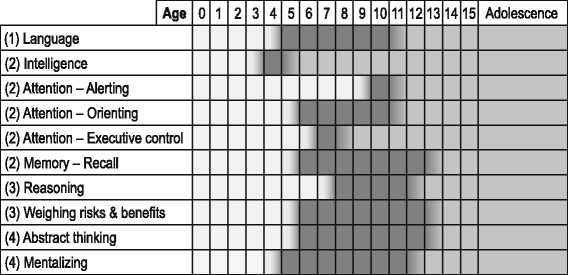Medical decision-making in children and adolescents: developmental and neuroscientific aspects
- PMID: 28482854
- PMCID: PMC5422908
- DOI: 10.1186/s12887-017-0869-x
Medical decision-making in children and adolescents: developmental and neuroscientific aspects
Abstract
Background: Various international laws and guidelines stress the importance of respecting the developing autonomy of children and involving minors in decision-making regarding treatment and research participation. However, no universal agreement exists as to at what age minors should be deemed decision-making competent. Minors of the same age may show different levels of maturity. In addition, patients deemed rational conversation-partners as a child can suddenly become noncompliant as an adolescent. Age, context and development all play a role in decision-making competence. In this article we adopt a perspective on competence that specifically focuses on the impact of brain development on the child's decision-making process.
Main body: We believe that the discussion on decision-making competence of minors can greatly benefit from a multidisciplinary approach. We adopted such an approach in order to contribute to the understanding on how to deal with children in decision-making situations. Evidence emerging from neuroscience research concerning the developing brain structures in minors is combined with insights from various other fields, such as psychology, decision-making science and ethics. Four capacities have been described that are required for (medical) decision-making: (1) communicating a choice; (2) understanding; (3) reasoning; and (4) appreciation. Each capacity is related to a number of specific skills and abilities that need to be sufficiently developed to support the capacity. Based on this approach it can be concluded that at the age of 12 children can have the capacity to be decision-making competent. However, this age coincides with the onset of adolescence. Early development of the brain's reward system combined with late development of the control system diminishes decision-making competence in adolescents in specific contexts. We conclude that even adolescents possessing capacities required for decision-making, may need support of facilitating environmental factors.
Conclusion: This paper intends to offer insight in neuroscientific mechanisms underlying the medical decision-making capacities in minors and to stimulate practices for optimal involvement of minors. Developing minors become increasingly capable of decision-making, but the neurobiological development in adolescence affects competence in specific contexts. Adequate support should be offered in order to create a context in which minors can make competently make decisions.
Keywords: Adolescents; Brain development; Children; Competence; Decision-making; Minors; Neuroscience.
Figures

References
-
- Unicef: Convention on the Rights of the Child. United Nations, Treaty Series 1577.3 1989.
-
- EU: Directive 2001/20/EC of the European Parliament and of the Council of 4 April 2001 on the approximation of the laws, regulations and administrative provisions of the member states relating to the implementation of good clinical practice in the conduct of clinical trials on medicinal products for human use. In Official Journal of the European Communities. 2001:34–44. - PubMed
-
- National Institutes of Health: Children’s assent to clinical trial participation. 2005. https://www.cancer.gov/about-cancer/treatment/clinical-trials/patient-sa.... Accessed 2 May 2017.
-
- Mayer RE, Moreno R. Nine ways to reduce cognitive load in multimedia learning. Educ Psychol. 2003;38:43–52. doi: 10.1207/S15326985EP3801_6. - DOI
Publication types
MeSH terms
LinkOut - more resources
Full Text Sources
Other Literature Sources
Medical

